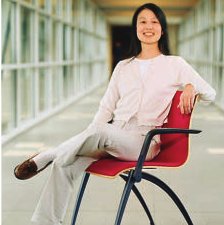
A professor of computer science at Carnegie Mellon University, Jeannette Wing has long been interested in the power of abstraction. She is a leading researcher in the area of formal methods, and has worked on diverse problems in software specification and verification, security, concurrent and distributed systems, and programming languages. Wing is also deeply engaged with a concept she calls computational thinking: the way computer scientists use decomposition, recursion, and algorithms to tackle difficult problems. As the current assistant director for computer and information science and engineering at the National Science Foundation (NSF), she now has the opportunity to put her talent for abstraction to use and help shape the future of the field.
You’re about a year and a half into your tenure at NSF. What’s it been like?
It’s been an eye-opening experience. It gives me a much better appreciation of the university/industry/government ecosystem, and how we all need to work together to advance the frontiers of science and engineering.
What role do you play within the organization?
I wear two hats. One is to act as a spokesperson for the field, a scientist who represents the whole computing community—and let me just use the word "computing" to stand for all of computer and information science and engineering. At the same time, I also have the opportunity to help guide and shape the frontiers of our field.
How’s that?
NSF is really a bottom-up organization. We listen to the computing community to find out what the trends are, where they’re going, and what their research interests are, and we try to respond to their needs.
"Computational thinking encompasses all the benefits of computational models and methods and tools and the abstractions we use."
Let’s talk about some of your most recent initiatives, such as the Cluster Exploratory program.
The Cluster Exploratory program enables us to offer software and services running on a Google-IBM cluster to the entire computing community. For a long time, we could see that there was something very exciting happening in industry with respect to these large data centers. But no university can really afford to build its own center and run it and pay for the power. Now, finally, researchers can access these resources and run their experiments at scale.
There’s also a second cluster at the University of Illinois at Urbana-Champaign (UIUC).
Yes, thanks to HP, Intel, and Yahoo!. It’s hosted at UIUC, but it’s being made available to all of academia. And this time, it’s not just the software and services that we’re providing, it’s access to the bare machine, so researchers can run experiments that go down to the processing level and below.
Has your involvement with NSF altered your own research interests?
Being here has increased my awareness of the need to do more fundamental research into privacy, and to understand things like information flow and use of information flow. What can or can we not guarantee with respect to preserving the privacy of citizens? How can we control what happens to the information we divulge about ourselves? What would be the equivalent of an impossibility result in privacy, in the way that we have for reliability?
Do you have time these days to actually do research of your own?
Yes, I do. Every program and division director has that opportunity, and I think it’s really important, because it keeps you current, it keeps you abreast of what’s happening, and it keeps you engaged. I try to devote the equivalent of at least one day a week to research—talking and emailing with my students, and working at nights and weekends. I also make it a point to try to go back to Carnegie Mellon at least once or twice a month.
Let’s talk about computational thinking, the term you coined to describe computer scientists’ unique way of approaching, understanding, and solving problems.
Computational thinking encompasses all the benefits of computational models and methods and tools and the abstractions that we use. It’s not just our metal tools, it’s our mental tools—that’s a phrase I like to use.
What sort of reception has it gotten?
There’s been an incredible groundswell of support and enthusiasm from around the world, from all sorts of cultures and institutions. And there’s been a lot of interest recently in computational thinking with respect to education. Many colleges and universities are revisiting their undergraduate curricula and realizing that an introductory computer science course, an introduction to Java programming, is hardly the best we can offer.
I understand you’re also focusing on the K12 level.
Absolutely. The Computer Science and Telecommunications Board, through a partnership with NSF, is going to be planning a series of workshops to address exactly that question: what are effective ways of learning, or teaching, computational thinking by, or to, children.



Join the Discussion (0)
Become a Member or Sign In to Post a Comment